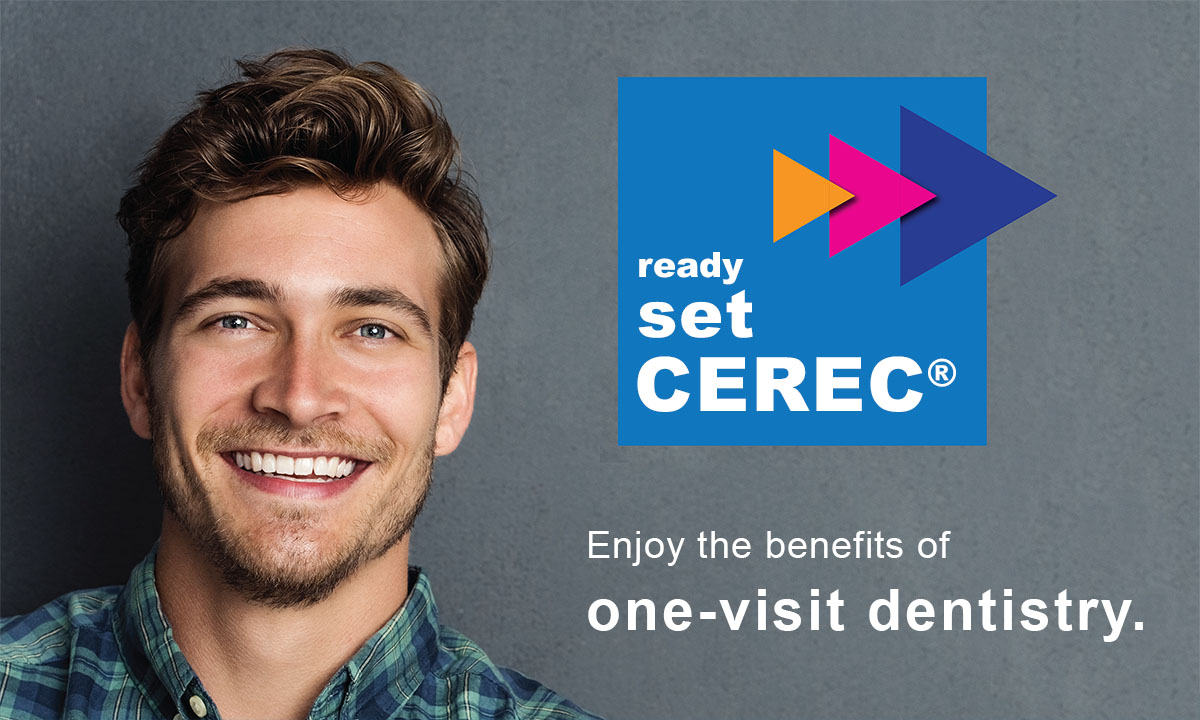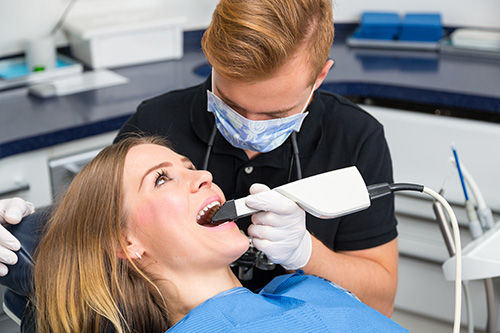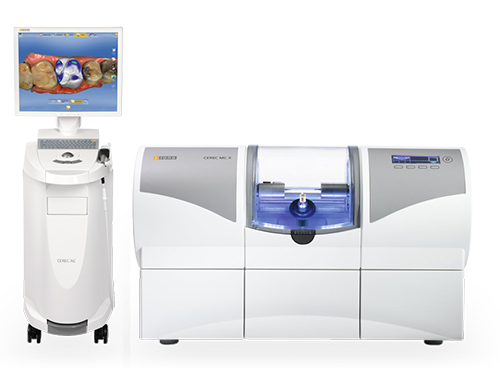
CEREC® transforms the traditional crown and restoration process into a streamlined, patient-centered experience. Instead of multiple visits and temporary restorations, this digital workflow allows your tooth to be prepared, scanned, and restored in one carefully coordinated visit. For many patients, that means less time in the dental chair overall and a single appointment that accomplishes what used to take weeks.
Because the system is digital from start to finish, the clinical team can work with a precise 3D representation of your tooth and surrounding structures. That level of accuracy makes it easier to produce a restoration that fits harmoniously with your bite and neighboring teeth. Patients frequently appreciate the convenience, while clinicians value the predictability of a fully integrated CAD/CAM process.
Aside from scheduling benefits, same-day restorations reduce the need for temporary crowns and the risks that can accompany them, such as sensitivity and marginal leakage. The result is a durable, well-fitting ceramic restoration delivered with fewer interim steps and more immediate outcomes.

The clinical visit begins with a detailed examination and preparation of the affected tooth. Instead of taking traditional putty impressions, the dentist uses an intraoral scanner to capture a high-resolution, three-dimensional image. This digital scan records the precise contours of the tooth and adjacent teeth, enabling a highly accurate design process without the discomfort of conventional impression materials.
Once the scan is complete, the design phase begins using specialized CAD software. The dentist or dental technician sculpts the restoration virtually, adjusting shape, occlusal contacts, and margins to achieve an optimal fit. Color and surface texture are considered at this stage to help the final piece blend with your natural dentition.
When the design is finalized, the file is sent to an on-site milling unit that carves your restoration from a solid ceramic block. After milling, the piece is polished, stained, or glazed as needed, then evaluated for fit and esthetics. Finally, the dentist bonds the restoration in place, providing a completed, functional tooth in the same appointment.

At the core of CEREC® is a combination of digital imaging, computer-aided design, and computer-aided manufacturing. This integrated approach reduces manual steps that can introduce variability, resulting in restorations with consistently accurate margins and occlusal relationships. Because the design is based on the patient’s actual anatomy, adjustments at the time of insertion are typically minimal.
The materials used for these restorations are advanced dental ceramics known for their strength and biocompatibility. Ceramic blocks come in a variety of shades and translucencies, allowing the clinical team to match the appearance of your natural teeth while providing long-term functional performance. Ceramic also resists staining and maintains its esthetic properties over time when properly cared for.
From a clinical standpoint, digital records created during the CEREC process become part of your chart, enabling efficient communication, predictable follow-up, and reproducible outcomes. The precision of the system supports conservative tooth preparation strategies, preserving as much natural structure as possible while delivering a well-fitting restoration.

Ceramic restorations produced with CEREC® are designed to be both strong and natural looking. When properly seated and maintained, these restorations can function for many years. The ceramic surfaces resist common forms of wear and discoloration, helping them retain a lifelike sheen that complements surrounding teeth.
Home care for ceramic restorations follows the same principles as natural teeth: regular brushing with a non-abrasive toothpaste, daily flossing, and routine professional cleanings and exams. During checkups, the dentist evaluates the restoration’s margins, contacts, and occlusion to ensure continued performance. Prompt attention to any new sensitivity or changes in bite helps preserve results over time.
In cases where a repair or replacement becomes necessary, the existing digital records can simplify the process. Because the workflow is digital, adjustments and remakes can be completed more predictably when compared with older analog methods.
When you elect a CEREC® restoration, the care team will review the treatment steps and answer any questions before the appointment begins. Expect a thorough exam and a discussion about restorative options that best match your functional needs and aesthetic goals. The visit is planned to minimize surprises and to make the digital workflow efficient and comfortable.
Our office integrates CEREC® technology as part of a broader approach to conservative, modern dentistry. Digital scanning reduces chair time and improves communication between team members, while chairside milling allows the dentist to oversee final adjustments and finish work directly. This hands-on control helps ensure the outcome aligns with your expectations.
Patients who choose this pathway often value the convenience and the immediate nature of the result. If you have questions about whether a single-visit restoration is appropriate for your situation, the clinical team at M. Kurt Berky, DDS, PC will explain candidly which restorative options best meet your long-term oral health goals.
CEREC® represents a modern option for patients seeking precise, natural-looking ceramic restorations without the multiple visits historically required for crown and onlay work. By combining intraoral scanning, digital design, and on-site milling, this approach delivers a predictable restoration in a single appointment for many clinical situations.
If you’re considering a restoration and want to know whether a CEREC® solution is right for you, speak with our team about candidacy, treatment sequencing, and what to expect at your visit. We’ll outline the clinical considerations and help you choose an option that balances preservation of natural tooth structure with esthetic and functional goals.
Contact us to learn more or to schedule a consultation with the doctor. Our team is happy to explain the process and help you determine if CEREC® is the right fit for your smile.

Today, there's no need to merely imagine how nice it would be to have a dental crown fabricated in a single visit. With CEREC technology and advanced systems of care, multiple trips to the dentist are a thing of the past! Now, one appointment is all it takes for our skilled and experienced dentist to design, fabricate, and place a naturally beautiful and long-lasting same-day crown. And, best of all, unlike conventional methods of care, you won't have to endure messy dental impressions, wear a temporary crown, or wait weeks for your permanent restoration to come back from the laboratory.
Offering a level of precision and comfort that exceeds conventional methods of care, CEREC technology is nothing short of amazing! Advanced CAD/CAM technology, which stands for computer-aided design and computer-aided manufacturing, enables our dentist to translate images from an optically scan tooth into a 3D virtual model upon which a custom crown can be digitally designed. Once this step is done, the detailed specs are then wirelessly transmitted to a chairside 3D milling machine to fabricate your new ceramic crown while you wait!
With conventional methods of care, a dental crown can take two to three visits to fabricate and place. However, thanks to the benefits of CEREC technology, we can prepare a tooth, then design, fabricate, and place your new crown, all while you wait.
With CEREC same-day crowns, there's none of the mess of conventional dental impressions, wearing dental temporaries, or waiting for the final crown to come back from the lab. Once the prepared tooth is optically scanned and the restoration digitally designed, your new crown can be milled from the highest quality of dental ceramics that very same visit.
CEREC same-day crowns and restorations are fabricated from the highest quality of dental ceramics. Because dental porcelain reflects light in much the same way as dental enamel, your new crown will look flawless, completely natural, and blend seamlessly with your smile.
A CEREC same-day crown offers much more than a convenient approach to getting a dental crown. It is also a high quality, naturally beautiful, extremely durable, and long-lasting dental restoration! The fact is, with proper oral hygiene and routine dental care your new crown will serve your smile well for many years to come.
CEREC is a chairside CAD/CAM system that designs and fabricates ceramic restorations in a single appointment. It combines intraoral scanning, computer-aided design and a milling unit to produce precise crowns, inlays and onlays while you wait. This workflow eliminates the need for traditional impressions and a provisional restoration in many cases.
At M. Kurt Berky, DDS, PC we use high-resolution digital scans to create a 3D model that the dentist customizes on screen. After the design is approved, the data is sent to a chairside milling unit that carves the restoration from a solid ceramic block. The dentist then adjusts, polishes and bonds the restoration for an esthetic, functional fit during that same visit.
CEREC routinely produces single crowns, inlays and onlays using durable ceramic materials that mimic natural tooth appearance. These restorations conserve healthy tooth structure when compared with fuller-coverage options and can be matched for color and translucency. The system is well suited to many posterior and anterior restorations that require both strength and esthetics.
CEREC can also be used to fabricate custom implant crowns in appropriate cases by integrating digital implant scans and component libraries. More complex prosthetics, full-arch reconstructions or frameworks that require specialized materials may still involve laboratory collaboration. Your dentist will recommend the best restoration type based on the extent of damage, occlusal needs and esthetic goals.
Traditional crowns typically require at least two appointments, an impression sent to a dental laboratory and a temporary crown while the permanent piece is fabricated. By contrast, a CEREC crown can be designed, milled and placed during one visit, reducing the number of office trips. This single-visit approach also reduces the time a tooth spends exposed after preparation.
Because CEREC uses digital design and in-office milling, it often produces a highly accurate fit that can be adjusted immediately. The absence of a provisional restoration eliminates issues related to temporary crown fit or cementation. Your dentist will verify contacts, occlusion and esthetics before final bonding to help ensure a predictable result.
Candidacy for CEREC depends on the extent of tooth damage, tooth location and functional demands rather than age alone. Small to moderate cavities, fractured cusps and failing restorations are commonly treated with same-day ceramic solutions when clinical conditions allow. Certain complex bite issues, extensive tooth loss or very large restorations may require alternative or laboratory-based approaches.
During an evaluation the dentist will review X-rays, digital scans and your dental history to determine whether a same-day restoration is appropriate. If a laboratory-fabricated restoration is preferable, the team will explain the reasons and outline the alternative workflow. The treatment plan is chosen to balance durability, fit and long-term prognosis for each tooth.
CEREC restorations are crafted from high-strength ceramic materials designed to resist wear while replicating the optical properties of natural teeth. Longevity is influenced by oral hygiene, bite forces, bruxism and the location of the restoration in the mouth. With appropriate care and regular dental monitoring, many patients maintain functional CEREC restorations for many years.
Routine dental visits allow the dentist to examine margins, contacts and occlusion so small concerns can be addressed before they become larger problems. If a restoration shows chipping or wear, adjustments or replacement are straightforward because digital records are available. Protective measures such as night guards for grinders can help extend the life of any ceramic restoration.
A CEREC appointment begins with tooth preparation and an intraoral scan that captures detailed three-dimensional images of the prepared tooth and adjacent teeth. The dentist then uses specialized software to design the restoration, refining contours, contacts and shade on screen while you wait. Once the design is approved, the file is sent to a chairside milling unit that fabricates the restoration from a solid ceramic block.
After milling the piece is stained, glazed or polished as needed and tried in to confirm fit and appearance before final bonding. Because the workflow is completed in office, most restorative procedures can be finished in a single visit without the need for a temporary crown. Your dentist will provide post-procedure care instructions to manage any sensitivity and support healing.
Local anesthesia is used during preparation so most patients experience minimal discomfort during a CEREC procedure. Because digital scanning replaces traditional putty impressions, many patients find the process more comfortable and report less gagging or unpleasant taste. The single-visit nature also avoids the common discomforts associated with ill-fitting temporary restorations.
After treatment some sensitivity to hot or cold and mild soreness of surrounding tissues is normal and typically subsides within a few days. Temporary dietary adjustments and conservative chewing on the treated side are usually recommended while the bond fully settles. If prolonged pain or unusual symptoms occur, contact the office for a follow-up evaluation.
Digital impressions are obtained with an intraoral scanner that creates a precise 3D model of the prepared tooth and surrounding dentition without the need for impression paste. This approach minimizes common problems such as voids, distortion and patient discomfort associated with traditional impressions. Digital files can be reviewed instantly and adjusted in real time to improve accuracy before fabrication.
The immediate availability of scan data also streamlines communication between the dentist and any collaborating lab or specialist and enables efficient archiving for future restoration needs. Because scanning is repeatable and highly accurate, it reduces the likelihood of remakes due to impression errors. Overall, digital impressions contribute to a faster, more predictable restorative experience.
CEREC can be used to design and mill many implant crowns by utilizing digital implant scan data and appropriate abutment libraries. Some cases require custom abutments or additional laboratory work, particularly when complex angulation, multi-component frameworks or specialized materials are involved. Your dentist will assess implant position, soft tissue profile and functional needs to determine the optimal workflow.
For extensive full-arch prosthetics, long-span bridges or complex implant-supported structures, a hybrid approach that combines digital design with laboratory fabrication may offer better control over fit and material selection. The treatment plan will explain whether an in-office CEREC restoration is appropriate or whether laboratory collaboration is necessary to meet the case requirements. The primary goal is to select the technique that provides strength, fit and esthetics for the long term.
Caring for a CEREC restoration is much like caring for a natural tooth: brush twice daily with a soft-bristled brush, floss daily and maintain regular dental checkups. Avoid using teeth as tools and minimize biting on very hard objects to reduce the risk of chipping. If you grind your teeth, discuss a night guard with your dentist to protect ceramic restorations from excessive forces.
During routine visits the dentist will assess margins, contacts and occlusion and perform polishing or minor adjustments as needed to preserve longevity. Digital records from the original CEREC design simplify reproduction or replacement should that ever be necessary. If you notice a change in fit, sensitivity or comfort, contact M. Kurt Berky, DDS, PC in Branford, CT for prompt evaluation and guidance.

Have questions or need to book your next appointment?
Our friendly staff at M. Kurt Berky, DDS, PC is ready to assist. Whether by phone or our online contact form, contacting us is simple and convenient. Start your journey to a healthier, brighter smile today by reaching out to our office.